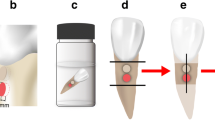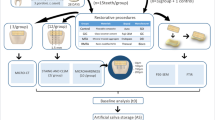Abstract
Objectives
The aim of this study was to evaluate the porosity and assess the root dentine to material interface of four root-end filling materials based on tricalcium silicate cement using two microscopy techniques.
Methods
The porosity of Bioaggregate, Biodentine, a prototype radiopacified tricalcium silicate cement (TCS-20-Zr) and intermediate restorative material (IRM) was evaluated after immersion for 28 days in Hank's balanced salt solution (HBSS) using mercury intrusion porosimetry. The root dentine to material interface of the cements when used as root-end filling materials in extracted human teeth was assessed after 28 days of dry storage and immersion in HBSS using a confocal microscope together with fluorescent tracers and also a field emission gun scanning electron microscope.
Results
Biodentine and IRM exhibited the lowest level or degree of porosity. The confocal microscopy used in conjunction to fluorescent tracers demonstrated that dry storage resulted in gaps at the root dentine to material interface and also cracks in the material with Biodentine being the most affected. Zinc was shown to be present in root dentine adjacent to the IRM restorations.
Conclusions
Dry storage of Biodentine resulted in changes in the material microstructure and cracks at the root dentine to Biodentine interface. Furthermore, the gaps resulting from material shrinkage allowed the passage of the fluorescent microspheres thus indicating that these gaps are significant and can potentially allow the passage of micro-organisms.




Similar content being viewed by others
References
Lodiene G, Kleivmyr M, Bruzell E, Ørstavik D (2011) Sealing ability of mineral trioxide aggregate, glass ionomer cement and composite resin when repairing large furcal perforations. Br Dent J 210:E7
Torabinejad M, Watson TF, Pitt Ford TR (1993) Sealing ability of a mineral trioxide aggregate when used as a root-end filling material. J Endod 19:591–5
Tang HM, Torabinejad M, Kettering JD (2002) Leakage evaluation of root-end filling materials using endotoxin. J Endod 28:5–7
De-Deus G, Reis C, Brandão C, Fidel S, Fidel RA (2007) The ability of Portland cement, MTA, and MTA Bio to prevent through-and-through fluid movement in repaired furcal perforations. J Endod 33:1374–7
Gandolfi MG, Sauro S, Mannocci F, Watson TF, Zanna S, Capoferri M, Prati C, Mongiorgi R (2007) New tetrasilicate cements as retrograde filling material: an in vitro study on fluid penetration. J Endod 33:742–5
De Bruyne MA, De Bruyne RJ, De Moor RJ (2006) Capillary flow porometry to assess the seal provided by root-end filling materials in a standardized and reproducible way. J Endod 32:206–9
Camilleri J (2008) Characterization of hydration products of mineral trioxide aggregate. Int Endod J 41:408–17
Belío-Reyes IA, Bucio L, Cruz-Chavez E (2009) Phase composition of ProRoot mineral trioxide aggregate by X-ray powder diffraction. J Endod 35:875–8
Camilleri J (2011) Characterization and hydration kinetics of tricalcium silicate cement for use as a dental biomaterial. Dent Mater 27:836–44
Formosa LM, Mallia B, Bull T, Camilleri J (2012) The microstructure and surface morphology of radiopaque tricalcium silicate cement exposed to different curing conditions. Dent Mater 28:584–95
Formosa LM, Mallia B, Camilleri J (2012) The effect of curing conditions on the physical properties of tricalcium silicate cement for use as a dental biomaterial. Int Endod J 45:326–36
Sarkar NK, Caicedo R, Ritwik P, Moiseyeva R, Kawashima (2005) Physicochemical basis of the biologic properties of mineral trioxide aggregate. J Endod 31:97–100
Biodentine™TM Scientific file (2010) Active Biosilicate TechnologyTM, Septodont, Saint-Maur-des-Fossés Cedex, France, R&D Department.
Veriodent web page: http://www.veriodent.com/pb/wp_d66c3664/wp_d66c3664.html Accessed 30-9-11.
Camilleri J, Kralj P, Veber M, Sinagra E (2012) Characterization and analyses of acid extractable and leached trace elements in dental cements. Int Endod J 45:737–43
Grech L, Mallia B, Camilleri J (2013) Characterization of set IRM, Biodentine, Bioaggregate and a prototype calcium silicate cement for use as root-end filling materials. Int Endod J 46:632–41
Grech L, Mallia B, Camilleri J (2013) Investigation of the physical properties of tricalcium silicate cement-based root-end filling materials. Dent Mater 29:e20–e28
Chong BS, Pitt Ford TR, Hudson MB (2003) A prospective clinical study of Mineral Trioxide Aggregate and IRM® when used as root-end filling materials in endodontic surgery. Int Endod J 36:520–6
Camilleri J (2011) Evaluation of the effect of intrinsic material properties and ambient conditions on the dimensional stability of white mineral trioxide aggregate and Portland cement. J Endod 37:239–45
Camilleri J (2013) Investigation of Biodentine as dentine replacement material. J Dent 41:600–10
Cook RA, Hover KC (1999) Mercury porosimetry of hardened cement pastes. Cem Conc Res 29:933–943
Webb PA, On C (1997) Analytical methods in fine particle technology. Micrometrics Instrument Corporation, Norcross
Milutinović-Nikolić AD, Medić VB, Vuković ZM (2007) Porosity of different dental luting cements. Dent Mater 23:674–678
Saghiri MA, Asgar K, Lotfi M, Karamifar K, Neelakantan P, Ricci JL (2012) Application of mercury intrusion porosimetry for studying the porosity of mineral trioxide aggregate at two different pH. Acta Odontol Scand 70:78–82
Lee YL, Lee BS, Lin FH et al (2004) Effects of physiological environments on the hydration behavior of mineral trioxide aggregate. Biomater 25:787–793
Namazikhah MS, Nekoofar MH, Sheykhrezae MS, Salariyeh S, Hayes SJ, Bryant ST, Mohammadi MM, Dummer PM (2008) The effect of pH on surface hardness and microstructure of mineral trioxide aggregate. Int Endod J 41:108–116
Atmeh AR, Chong EZ, Richard G, Festy F, Watson TF (2012) Dentin–cement interfacial interaction: calcium silicates and polyalkenoates. J Dent Res 91:454–9
Sauro S, Osorio R, Osorio E, Watson TF, Toledano M (2013) Novel light-curable materials containing experimental bioactive micro-fillers remineralise mineral-depleted bonded–dentine interfaces. J Biomater Sci Polym Ed 24:940–56
Profeta AC, Mannocci F, Foxton R, Watson TF, Feitosa VP, De Carlo B, Mongiorgi R, Valdré G, Sauro S (2013) Experimental etch-and-rinse adhesives doped with bioactive calcium silicate-based micro-fillers to generate therapeutic resin–dentin interfaces. Dent Mater 29:729–41
de Oliveira MT, Arrais CA, Aranha AC, de Paula EC, Miyake K, Rueggeberg FA, Giannini M (2010) Micromorphology of resin–dentin interfaces using one-bottle etch & rinse and self-etching adhesive systems on laser-treated dentin surfaces: a confocal laser scanning microscope analysis. Las Surg Med 42:662–70
Camilleri J, Pitt Ford TR (2008) Evaluation of the effect of tracer pH on the sealing ability of glass ionomer cement and mineral trioxide aggregate. J Mater Sci: Mater Med 19:2941–8
Michaïlesco P, Boudeville P (2003) Calibrated latex microspheres percolation: a possible route to model endodontic bacterial leakage. J Endod 29:456–62
Profeta AC, Mannocci F, Foxton RM, Thompson I, Watson TF, Sauro S (2012) Bioactive effects of a calcium/sodium phosphosilicate on the resin–dentine interface: a microtensile bond strength, scanning electron microscopy, and confocal microscopy study. Eur J Oral Sci 120:353–62
Camilleri (2010) The sealing ability of modified experimental Portland cements with potential use in dentistry. Adv Cem Res 22:115–121
Taylor HFW (1997) Cement chemistry, 2nd edn. Thomas Telford, UK
Camilleri J (2011) Scanning electron microscopic evaluation of the material interface of adjacent layers of dental materials. Dent Mater 27:870–8
Acknowledgments
The Faculty of Dental Surgery and the Research Grant Committee, University of Malta for funding; Mineral Research Processing, Septodont and Verio Dental Co. Ltd for the materials; Ing. Mr J. Camilleri of the Department of Metallurgy and Materials Engineering, Faculty of Engineering, University of Malta; Mr. Guillaume Potier of the Department of Civil and Environmental Engineering, Ecole de Mines, Douai, France; ERDF (Malta) for the financing of the testing equipment through the project: “Developing an Interdisciplinary Material Testing and Rapid Prototyping R&D Facility (Ref. no. 012)”.
Declaration
The authors declare they have no conflict of interest.
Author information
Authors and Affiliations
Corresponding author
Rights and permissions
About this article
Cite this article
Camilleri, J., Grech, L., Galea, K. et al. Porosity and root dentine to material interface assessment of calcium silicate-based root-end filling materials. Clin Oral Invest 18, 1437–1446 (2014). https://doi.org/10.1007/s00784-013-1124-y
Received:
Accepted:
Published:
Issue Date:
DOI: https://doi.org/10.1007/s00784-013-1124-y




